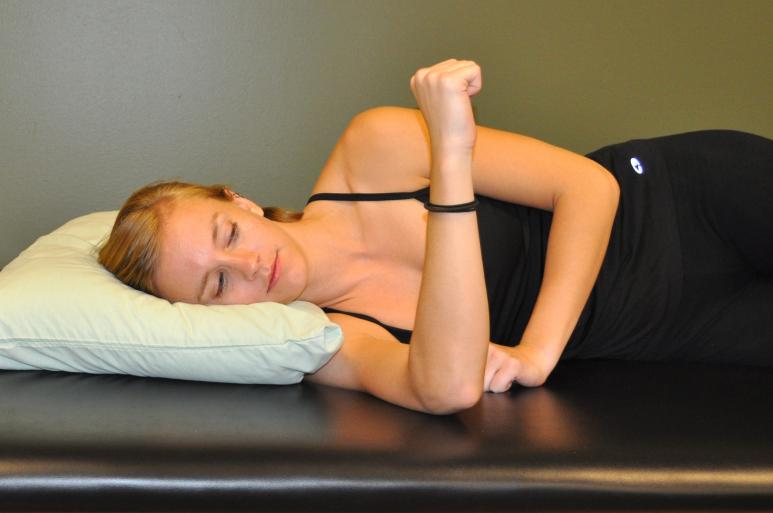The rotator cuff is a small group of muscles that rotates your shoulder and therefore helps control its movements. Rotator cuff exercises maintain your shoulders robust and pain-free and aid to rehabilitate any shoulder injury. The primary symptom of a rotator cuff injury is a persistent mild discomfort in the front or side of your shoulder. Lifting your arm up or doing daily tasks can become extremely excruciating. Strengthening the rotator cuff muscles through physical therapy exercises can help reduce the discomfort and repair the muscles. You will be able to move your arm freely, elevate objects without agony, and do daily tasks with ease. Here are a few rotator cuff exercises you can do. Scroll down!
What Are The Rotator Cuff Muscles?
Understanding shoulder anatomy is essential for both injury prevention and enhancing shoulder mobility.
The rotator cuff muscles are a group of four shoulder muscles that support the movements of your arms and shoulders. Also referred to as SITS, the four muscles of the rotator cuff are:
-
Supraspinatus
-
Infraspinatus
-
Teres Minor
-
Subscapularis
These muscles help stabilize your shoulders and move them in, out, up, back, and down when your arms do various duties.
Without enough strength, equilibrium, and stability in the rotator cuff, it would be impossible to raise your arms and do various movements freely. If you ever had a shoulder injury, you know that even elevating your hand can become exceedingly excruciating. So, what causes rotator cuff muscle weakness or pain? Find out in the next section.
Best Exercises To Strengthen The Rotator
1. Side-lying External Rotation

Target – External rotators
How To Do
-
Lie down on a yoga mat, and support your head on a foam roller or curled cloth. Stretch your other arm out in line with your bottom ear or support your cranium with your forearm. Slightly flex your knees.
-
Hold a 1-pound dumbbell at your midsection with the hand of the affected shoulder. Flex your elbow so that your upper arm is perpendicular to the forearm. Keep your palm facing away from you. Place a towel below your forearm for support.
-
Slowly, draw your hand up, keeping the elbow flexed and not allowing it to separate from your waist Squeeze the rear of your arm.
-
Bring it back to the starting position with control.
2. High-To-Low Rows
Target – Rhomboidsi , traps, and lats.
How To Do
-
Hold the rope attached to the cable bundle with both palms.
-
Step back and get into a staggered posture (one foot in front of the other). Keep your core taut, and weight on the front foot.
-
Pull the ropes towards your chest with your forearms going down and back to 45 degrees. Squeeze your shoulder blades together.
-
Release the hold slowly and extend your arms entirely without hunching or curving your shoulders.
-
Repeat.
3. Reverse Fly
Target — Posterior deltoids, rhomboids, and traps.
How To Do
-
Kneel on both legs. Hold light weights with your palm facing inward, hands under your shoulders.
-
Slowly, draw your wrists up to shoulder height, keeping the elbow bowed and rotating your middle fingers up to the ceiling
-
Bring your limbs back to the starting positionSets And Reps
-
3 sets of 8 repetitions, 1 additional set with the injured side
4. Lawn Mower Pull

Target – Posterior deltoids, pectorals, lats, biceps, and hamstrings.
How To Do
-
Hold one edge of a broad resistance band. Secure it to a wall or bar at shoulder height and then stand on the other end of the band. Twist the band in your hand for the required amount of resistance so the band is taut.
-
Stand with your feet shoulder-width apart, knees slightly bowed, and the free hand placed on your midsection. This is your starting position.
-
Straighten your ankles and rise. As you do so, draw the resistance band towards your hip with your elbow pointing back, and your shoulder blades compressed.
-
Straighten your arm to the starting position with control and without rounding your shoulders.
5. Doorway Stretch
Target — Subscapularis and pectoralis.
How To Do
-
Stand near a door with the afflicted arm facing away from it. Secure a resistance band on the latch of the door. Hold the other end of the resistance band with your affected limb.
-
Bend your elbow so that the forearm is perpendicular to the upper arm. This is the beginning position.
-
Keeping your forearm fastened to the torso, draw the resistance band away from your body.
-
Return to the beginning position with control and repeat.
Read Also: Effective Push Up Techniques for Women
6. Pendulum
Target – Shoulder joints
How To Do
-
Rest your non-injured good limb on a table and lean over. Keep one foot in front of the other and the affected limb dangling.
-
Start swaying your body so that your arm begins to swing as well. Direct the pendulum in clockwise and anticlockwise directions.
7. Crossover Arm Stretch-Low Rows

Target – Posterior deltoids, lats, and triceps.
How To Do
-
Place the hand of the affected limb on the opposite shoulder. You may use your uninjured arm as support to do so.
-
Grab the elbow of the afflicted arm with your non-injured uninjured arm and elevate it to shoulder level.
-
Gently and steadily, draw your forearm toward the opposite shoulder. You will feel a stretch along the side and rear of your shoulder.
-
Hold it for 20 seconds and repeat.